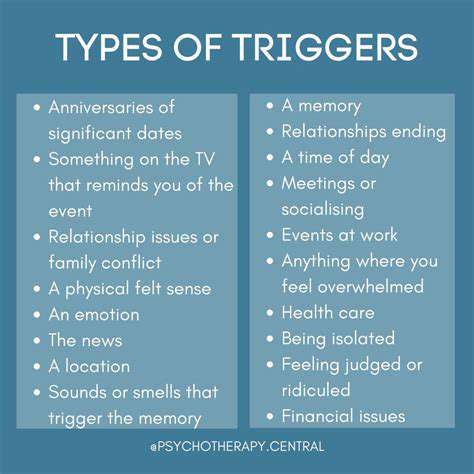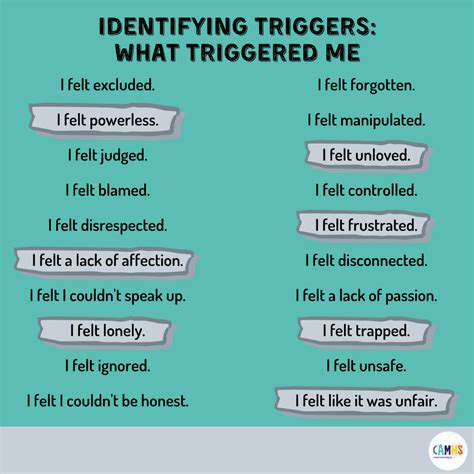Identifying Emotional Triggers for Better Mental Well Being
The Nature of Emotional Triggers
Understanding the Origins of Emotional Triggers
Emotional triggers are often rooted in past experiences, particularly those that may have been distressing or unresolved. These can stem from childhood experiences, traumatic events, or significant relationships. When we encounter situations reminiscent of these experiences, our emotional responses can become automatic, bypassing rational thought. Understanding this origin can provide important insights into our behavior and reactions.
It’s essential to recognize that not all emotional triggers will arise from trauma. They can also develop from socio-cultural conditioning or learned responses from family and peers. This means that our reactions can be influenced by what we have observed and internalized throughout our lives. Identifying these triggers is a crucial first step in mitigating their negative effects on our mental health.
Becoming aware of emotional triggers often involves both reflection and observation. Keeping a journal can be a beneficial practice; documenting situations that provoke strong emotional reactions can help establish patterns. Over time, this can lead to a deeper understanding of what specific thoughts or environments lead to intense feelings, allowing for greater self-awareness.
In addition to personal reflection, discussing triggers with a therapist can provide professional insight. Therapists can offer strategies to address these triggers constructively, helping individuals to cope with their emotional responses in healthier ways. By understanding the origins and mechanisms behind our triggers, we can learn to manage them more effectively.
Strategies for Managing Emotional Triggers
Once emotional triggers have been identified, the next step is to develop strategies for managing them. One effective approach is mindfulness, which encourages individuals to become aware of their emotions without judgment. Mindfulness practices, such as meditation or deep-breathing exercises, can provide tools to navigate emotional turbulence more effectively and foster resilience.
Another valuable strategy is cognitive-behavioral techniques. These methods focus on identifying negative thought patterns associated with emotional triggers and replacing them with more constructive thoughts. This reframing can lessen the emotional impact of a trigger, allowing individuals to respond more rationally and calmly to challenging situations.
Creating a support network is also vital for managing emotional triggers. Friends, family, or support groups can offer a listening ear, validation, and new perspectives. By sharing experiences and coping strategies with others who understand, individuals can feel less isolated and more empowered to handle their emotional responses.
Lastly, establishing personal boundaries can help limit exposure to known triggers. This might involve avoiding certain environments or relationships that consistently provoke negative emotions. By creating a safe space for oneself, individuals can focus on healing and developing healthier emotional responses, ultimately leading to improved mental well-being.
Common Types of Triggers

External Triggers
External triggers are events or situations that can spark an emotional response. These can include loud noises, crowded places, or even specific weather conditions. Understanding your external triggers can greatly enhance your awareness and coping strategies. By observing these triggers, you can proactively manage your reactions to them.
Social interactions often represent significant external triggers for many individuals. For instance, a disagreement with a friend or colleague can provoke feelings of anxiety or anger. These emotions can lead to changes in behavior that affect relationships and personal well-being.
Physical environments also play a crucial role in affecting our emotions. Entering a cluttered space may induce stress, while a serene landscape can evoke calmness. Being mindful of your surroundings can help you create a more supportive atmosphere.
By recognizing external triggers, you can develop strategies to minimize their impact. This may involve avoiding specific situations, employing relaxation techniques, or seeking social support when faced with these challenges.
Internal Triggers
Internal triggers stem from within, often relating to our thoughts or bodily sensations. Feelings of inadequacy or self-doubt can lead to severe emotional responses that undermine our confidence. Managing these internal triggers is key to maintaining emotional balance.
Physical sensations can also activate emotional responses, such as rapid heartbeat or shallow breathing. These bodily reactions can be linked to past experiences, making them powerful internal triggers. Recognizing these sensations can help you intervene before emotions escalate.
Our thoughts and beliefs play a substantial part in shaping internal triggers. Negative self-talk or cognitive distortions can perpetuate a cycle of emotional distress. Identifying and challenging these thoughts is essential for improving mental health.
Practicing mindfulness and self-reflection can aid in recognizing these internal triggers. By fostering self-awareness, you can respond to your thoughts and feelings more effectively, ultimately leading to improved emotional well-being.
Emotional Responses to Triggers
The way we respond to triggers can significantly impact our mental health. Emotional responses, whether positive or negative, can dictate how we navigate challenges in our lives. Understanding these responses is vital for personal growth.
Common emotional responses include anxiety, anger, sadness, and joy. Recognizing these emotions as they arise allows for timely interventions. If you can identify the triggers, you can begin to manage the accompanying emotions more effectively.
Developing coping techniques tailored to your emotional responses is crucial. This may include deep breathing exercises, journaling, or talking to a trusted friend. These tools can help you process your emotions and respond in healthier ways.
Moreover, reflecting on past experiences can reveal patterns in your emotional responses. By learning from these instances, you can better prepare yourself for future triggers, cultivating resilience and emotional fortitude.
Creating a Support System
A strong support system can make a significant difference in managing emotional triggers. Building relationships with friends, family, or mental health professionals creates a safety net for when challenges arise. These connections can offer guidance, understanding, and reassurance.
It’s important to communicate openly about your triggers with those in your support system. Sharing your experiences can foster empathy and enable others to provide the appropriate support. An open dialogue can lead to greater understanding and stronger connections.
Engaging in support groups can also be beneficial, as they provide a community of individuals facing similar struggles. Sharing coping strategies and experiences can empower you and promote healing. It's a reminder that you are not alone in your journey.
Finally, actively seeking help when needed is not a sign of weakness but rather a strength. Knowing when to lean on your support system is crucial for maintaining mental and emotional health.
Steps to Recognize and Manage Triggers

Understanding Emotional Triggers
Emotional triggers are stimuli that provoke intense emotional reactions, often rooted in past experiences. They can arise from various sources, including interpersonal interactions, environmental cues, or memories. Recognizing these triggers is crucial for emotional regulation and mental well-being.
Understanding the nature of triggers helps individuals identify what specific events or situations cause discomfort or distress. For instance, a particular scent may remind someone of a stressful event, leading to anxiety. By pinpointing these triggers, one can begin to address the underlying issues effectively.
It’s important to note that triggers can be both positive and negative. While negative triggers can lead to distress, positive triggers can evoke feelings of happiness and safety. Acknowledging this duality is essential for navigating emotional landscapes.
Diving into Personal Experiences
To effectively manage emotional triggers, individuals should engage in self-reflection and introspection. Writing in a journal can be a helpful practice, allowing one to track incidents that provoke strong emotions. This awareness sets the stage for proactive coping strategies.
Additionally, discussing experiences with a trusted friend or therapist can provide insights into patterns and underlying causes. Sharing emotions in a supportive environment often reduces their intensity and fosters healing. Finding solidarity in shared experiences can be incredibly therapeutic.
Recognizing personal experiences tied to specific triggers also enables individuals to create avoidance strategies when necessary. By setting boundaries and limiting exposure to triggering situations, one can cultivate a more stable emotional environment.
Developing Coping Strategies
Once emotional triggers are identified, the next step is developing effective coping strategies. Mindfulness practices, such as meditation and deep breathing, can help manage stress and emotional responses. These techniques promote a greater sense of control during triggering events.
Another valuable strategy is cognitive reframing, which involves changing negative thought patterns associated with triggers. By shifting perspectives, individuals can reduce the emotional charge of a trigger. Employing positive affirmations can significantly alter one’s response to stress.
Finally, seeking professional help through therapy can equip individuals with advanced skills for managing triggers. Therapists can provide tailored strategies and support, fostering resilience. With the right tools and support, individuals can navigate their triggers effectively.